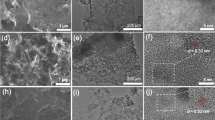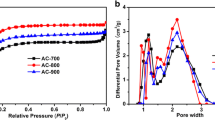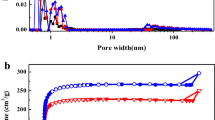Abstract
Activated carbon materials derived from biomass for supercapacitors have received great attention due to their natural abundance and low cost. The agricultural waste walnut green peel can be a promising activated carbon electrode material and resource utilization of it would effectively alleviate the environmental pollution problem. Here we reported the N-doped activated carbon materials (N/ACs) from walnut green peel using melamine as the nitrogen source. N/ACs showed obvious pore structure, high specific surface area, low resistance, and fast charge transfer rate. Thereinto, the optimized N/AC-2 showed the most excellent and better capacitive performance, with the specific capacitance of 304.5 F g−1 at 0.5 A g−1. N/AC-2 exhibited high energy density (40.05 W h kg−1) and power density (22.5 kW kg−1) as the supercapacitor electrode. In addition, the capacitance retention rate of N/AC-2 remained 95.2% after 3000 cycles at 10 A g−1. Our work demonstrated that the prepared N/ACs would be more promising electrode materials for supercapacitors.








Similar content being viewed by others
Data availability
The datasets used and/or analysed during the current study are available from the corresponding author on reasonable request.
References
Zhou M, Wang Q, Yuan Y, Luo S-H, Zhang Y-H, Liu X (2021) Biocarbon with different microstructures derived from corn husks and their potassium storage properties. Rare Met 40:3166–3174. https://doi.org/10.1007/s12598-021-01775-4
Wang D, Wang Q, Tan M, Wang S, Luo S, Hou P, Zhang Y, Yan S, Liu X (2022) Biomass CQDs derivate carbon as high-performance anode for K-ion battery. J Alloys Compd 922:166260. https://doi.org/10.1016/j.jallcom.2022.166260
Yan SX, Wang Q, Luo SH, Zhang YH, Liu X, Liu YG, Wang ZY, Hao AM, Yi TF (2020) Coal-based S hybrid self-doped porous carbon for high-performance supercapacitors and potassium-ion batteries. J Power Sources 461:228151. https://doi.org/10.1016/j.jpowsour.2020.228151
Liu L, Taberna P-L, Dunn B, Simon P (2021) Future directions for electrochemical capacitors. ACS Energy Lett 6:4311–4316. https://doi.org/10.1021/acsenergylett.1c01981
Jeanmairet G, Rotenberg B, Salanne M (2022) Microscopic simulations of electrochemical double-layer capacitors. Chem Rev 122:10860–10898. https://doi.org/10.1021/acs.chemrev.1c00925
Zhao J, Burke AF (2020) Electrochemical capacitors: materials, technologies and performance. Energy Stor Mater 36:31–55. https://doi.org/10.1016/j.ensm.2020.12.013
Yan SX, Luo SH, Feng J, Li PW, Guo R, Wang Q, Zhang YH, Liu YG, Bao S (2020) Rational design of flower-like FeCo2S4/reduced graphene oxide films: novel binder-free electrodes with ultra-high conductivity flexible substrate for high-performance all-solid-state pseudocapacitor. Chem Eng J 381:122695. https://doi.org/10.1016/j.cej.2019.122695
Yan SX, Luo SH, Liu H, Yang L, Wang Q, Zhang YH, Liu X (2022) In-situ partial reduction-sulfurized Fe3O4@FeS based on pickling iron red as a versatile electrode for high-performance lithium ion batteries and supercapacitor devices. Surf Coat Tech 429:127980. https://doi.org/10.1016/j.surfcoat.2021.127980
Yan SX, Luo SH, Wang Q, Zhang YH, Liu X (2021) Rational design of hierarchically sulfide and MXene-reinforced porous carbon nanofibers as advanced electrode for high energy density flexible supercapacitors. Compos Part B Eng 224:109246. https://doi.org/10.1016/j.compositesb.2021.109246
Yan SX, Luo SH, Feng J, Yang L, Li PW, Wang Q, Zhang YH, Liu X, Chang LJ (2021) Asymmetric, flexible supercapacitor based on Fe-Co alloy@sulfide with high energy and power density. ACS Appl Mater Interfaces 13:49952–49963. https://doi.org/10.1021/acsami.1c14537
Prasankumar T, Salpekar D, Bhattacharyya S, Manoharan K, Yadav RM, Campos Mata MA, Miller KA, Vajtai R, Jose S, Roy S, Ajayan PM (2022) Biomass derived hierarchical porous carbon for supercapacitor application and dilute stream CO2 capture. Carbon 199:249–257. https://doi.org/10.1016/j.carbon.2022.07.057
Tian XD, Chen ZC, Hou J, Li ZQ (2022) Sustainable utilization method of using coal gasification fine ash to prepare activated carbon for supercapacitor. J Clean Prod 363:132524. https://doi.org/10.1016/j.jclepro.2022.132524
Wang Y, Chang Z, Qian M, Zhang Z, Lin J, Huang F (2019) Enhanced specific capacitance by a new dual redox-active electrolyte in activated carbon-based supercapacitors. Carbon 143:300–308. https://doi.org/10.1016/j.carbon.2018.11.033
Huang L, Wang S, Zhang Y, Huang XH, Peng JJ, Yang F (2022) Preparation of a N-P co-doped waste cotton fabric-based activated carbon for supercapacitor electrodes. Carbon 188:546. https://doi.org/10.1016/j.carbon.2021.12.013
Chen J, Xie J, Jia CQ, Song C, Hu J, Li H (2022) Economical preparation of high-performance activated carbon fiber papers as self-supporting supercapacitor electrodes. Chem Eng J 450:137938. https://doi.org/10.1016/j.cej.2022.137938
Li D, Zhao L, Cao X, Xiao Z, Nan H, Qiu H (2020) Nickel-catalyzed formation of mesoporous carbon structure promoted capacitive performance of exhausted biochar. Chem Eng J 406:126856. https://doi.org/10.1016/j.cej.2020.126856
Wu H, Yuan W, Yuan X, Cheng L (2022) Atmosphere-free pyrolysis of harakeke fiber: a new chamber-induced activation methodology for porous carbon electrodes in supercapacitors. Energy Stor Mater 50:514–524. https://doi.org/10.1016/j.ensm.2022.05.046
Li W, Yang X, Chen Z, Lv T, Wang X, Qiu J (2022) Synthesis and structure regulation of armor-wearing biomass-based porous carbon: suppression the leakage current and self-discharge of supercapacitors. Carbon 196:136–145. https://doi.org/10.1016/j.carbon.2022.04.037
Shang T, Xu Y, Li P, Han J, Wu Z, Tao Y, Yang Q-H (2020) A bio-derived sheet-like porous carbon with thin-layer pore walls for ultrahigh-power supercapacitors. Nano Energy 79:104531. https://doi.org/10.1016/j.nanoen.2020.104531
Sundriyal S, Shrivastav V, Pham HD, Mishra S, Deep A, Dubal DP (2021) Advances in bio-waste derived activated carbon for supercapacitors: trends, challenges and prospective. Resour Conserv Recycl 169:105548. https://doi.org/10.1016/j.resconrec.2021.105548
Wang F, Liu X, Duan G, Yang H, Cheong JY, Lee J, Ahn J, Zhang Q, He S, Han J, Zhao Y, Kim I-D, Jiang S (2021) Wood-derived, conductivity and hierarchical pore integrated thick electrode enabling high areal/volumetric energy density for hybrid capacitors. Small 17:2102532. https://doi.org/10.1002/smll.202102532
Zhang C, Duan S, Zhou M, Liu Z, Ren H, Sasaki S-i, Wang X-F (2022) Electropolymerized chlorophyll derivative biopolymers for supercapacitors. Chem Eng J 450:138000. https://doi.org/10.1016/j.cej.2022.138000
Liu ZL, Wan X, Wang Q, Tian D, Hu JG, Huang M, Shen F, Zeng YM (2021) Performances of a multi-product strategy for bioethanol, lignin, and ultra-high surface area carbon from lignocellulose by PHP (phosphoric acid plus hydrogen peroxide) pretreatment platform. Renew Sust Energ Rev 150:111503. https://doi.org/10.1016/j.rser.2021.111503
Zhou Y, Qin S, Verma S, Sar T, Sarsaiya S, Ravindran B, Liu T, Sindhu R, Patel AK, Binod P, Varjani S, Rani Singhnia R, Zhang Z, Awasthi MK (2021) Production and beneficial impact of biochar for environmental application: a comprehensive review. Bioresour Technol 337:125451. https://doi.org/10.1016/j.biortech.2021.125451
Sun Y, Xu D, Wang S (2022) Self-assembly of biomass derivatives into multiple heteroatom-doped 3D-interconnected porous carbon for advanced supercapacitors. Carbon 199:258–267. https://doi.org/10.1016/j.carbon.2022.08.026
Zhou M, Yan S-X, Wang Q, Tan M-X, Wang D-Y, Yu Z-Q, Luo S-H, Zhang Y-H, Liu X (2022) Walnut septum-derived hierarchical porous carbon for ultra-high-performance supercapacitors. Rare Met 41:2280–2291. https://doi.org/10.1007/s12598-021-01957-0
Jia H, Sun J, Xie X, Yin K, Sun L (2019) Cicada slough-derived heteroatom incorporated porous carbon for supercapacitor: Ultra-high gravimetric capacitance. Carbon 143:309–317. https://doi.org/10.1016/j.carbon.2018.11.011
Bo X, Xiang K, Zhang Y, Shen Y, Chen S, Wang Y, Xie M, Guo X (2019) Microwave-assisted conversion of biomass wastes to pseudocapacitive mesoporous carbon for high-performance supercapacitor. J Energy Chem 39:1–7. https://doi.org/10.1016/j.jechem.2019.01.006
Chen JL, Liu JL, Wu DD, Bai X, Lin YT, Wu TT, Zhang C, Chen DL, Li HZ (2021) Improving the supercapacitor performance of activated carbon materials derived from pretreated rice husk. J Energy Storage 44:103432. https://doi.org/10.1016/j.est.2021.103432
Usha Rani M, Nanaji K, Rao TN, Deshpande AS (2020) Corn husk derived activated carbon with enhanced electrochemical performance for high-voltage supercapacitors. J Power Sources 471:228387. https://doi.org/10.1016/j.jpowsour.2020.228387
Shang Z, An X, Zhang H, Shen M, Baker F, Liu Y, Liu L, Yang J, Cao H, Xu Q, Liu H, Ni Y (2020) Houttuynia-derived nitrogen-doped hierarchically porous carbon for high-performance supercapacitor. Carbon 161:62–70. https://doi.org/10.1016/j.carbon.2020.01.020
Fu M, Chen W, Zhu X, Yang B, Liu Q (2019) Crab shell derived multi-hierarchical carbon materials as a typical recycling of waste for high performance supercapacitors. Carbon 141:748–757. https://doi.org/10.1016/j.carbon.2018.10.034
Park S, Seo B, Shin D, Kim K, Choi W (2022) Sodium-chloride-assisted synthesis of nitrogen-doped porous carbon shells via one-step combustion waves for supercapacitor electrodes. Chem Eng J 433:134486. https://doi.org/10.1016/j.cej.2021.134486
El-Mahdy AFM, Yu TC, Kuo S-W (2021) Synthesis of multiple heteroatom–doped mesoporous carbon/silica composites for supercapacitors. Chem Eng J 414:128796. https://doi.org/10.1016/j.cej.2021.128796
Wang M, Yang J, Liu S, Che X, He S, Chen G, Qiu J (2023) Nitrogen-doped porous carbon electrode for aqueous iodide redox supercapacitor. Chem Eng J 451:138501. https://doi.org/10.1016/j.cej.2022.138501
Xia C, Surendran S, Ji S, Kim D, Chae Y, Kim J, Je M, Han MK, Choe WS, Choi CH, Choi H, Kim JK, Sim U (2022) A sulfur self-doped multifunctional biochar catalyst for overall water splitting and a supercapacitor from Camellia japonica flowers. Carbon Energy 4:491–505. https://doi.org/10.1002/cey2.207
Liu ZS, Qin AM, Zhang KY, Lian P, Yin XD, Tan H (2021) Design and structure of nitrogen and oxygen co-doped carbon spheres with wrinkled nanocages as active material for supercapacitor application. Nano Energy 90:106540. https://doi.org/10.1016/j.nanoen.2021.106540
Singh A, Sharma R, Pant D, Malaviya P (2021) Engineered algal biochar for contaminant remediation and electrochemical applications. Sci Total Environ 774:145676. https://doi.org/10.1016/j.scitotenv.2021.145676
Han W, Wang H, Xia K, Chen S, Yan P, Deng T, Zhu W (2020) Superior nitrogen-doped activated carbon materials for water cleaning and energy storing prepared from renewable leather wastes. Environ Int 142:105846. https://doi.org/10.1016/j.envint.2020.105846
Sekhon SS, Kaur P, Park J-S (2021) From coconut shell biomass to oxygen reduction reaction catalyst: Tuning porosity and nitrogen doping. Renew Sust Energ Rev 147:111173. https://doi.org/10.1016/j.rser.2021.111173
Wan Z, Sun Y, Tsang DCW, Khan E, Yip ACK, Ng YH, Rinklebe J, Ok YS (2020) Customised fabrication of nitrogen-doped biochar for environmental and energy applications. Chem Eng J 401:126136. https://doi.org/10.1016/j.cej.2020.126136
Zhang C, Wang Y, Zhang X, Wang R, Kou L, Wang J, Li R, Fan C (2021) Millimeter-level nitrogen modified activated carbon spheres assisted Bi4Ti3O12 composites for bifunctional adsorption/photoreduction of CO2. Chem Eng J 417:128218. https://doi.org/10.1016/j.cej.2020.128218
Park JM, Woo HC, Jhung SH (2021) Effective CO2 adsorption at low pressure over nitrogen-enriched porous carbons, derived from melamine-loaded polyaniline. Chem Eng J 412:128641. https://doi.org/10.1016/j.cej.2021.128641
Mian MM, Liu G, Zhou H (2020) Preparation of N-doped biochar from sewage sludge and melamine for peroxymonosulfate activation: N-functionality and catalytic mechanisms. Sci Total Environ 744:128641. https://doi.org/10.1016/j.scitotenv.2020.140862
Tian N, Gao M, Liu X-H, Liu X, Yang T, Xie W, Wu J (2022) Activated carbon derived from walnut green peel as an electrode material for high-performance supercapacitors. Biomass Conv Bioref. https://doi.org/10.1007/s13399-021-02103-7
Martínez-Casillas DC, Mascorro-Gutiérrez I, Arreola-Ramos CE, Villafán-Vidales HI, Arancibia-Bulnes CA, Ramos-Sánchez VH, Cuentas-Gallegos AK (2019) A sustainable approach to produce activated carbons from pecan nutshell waste for environmentally friendly supercapacitors. Carbon 148:403–412. https://doi.org/10.1016/j.carbon.2019.04.017
Sinha P, Yadav A, Tyagi A, Paik P, Yokoi H, Naskar AK, Kuila T, Kar KK (2020) Keratin-derived functional carbon with superior charge storage and transport for high-performance supercapacitors. Carbon 168:419–438. https://doi.org/10.1016/j.carbon.2020.07.007
Pontiroli D, Scaravonati S, Magnani G, Fornasini L, Bersani D, Bertoni G, Milanese C, Girella A, Ridi F, Verucchi R, Mantovani L, Malcevschi A, Riccò M (2019) Super-activated biochar from poultry litter for high-performance supercapacitors. Microporous Mesoporous Mater 285:161–169. https://doi.org/10.1016/j.micromeso.2019.05.002
Gu B, Su H, Chu X, Wang Q, Huang H, He J, Wu T, Deng W, Zhang H, Yang W (2019) Rationally assembled porous carbon superstructures for advanced supercapacitors. Chem Eng J 361:1296–1303. https://doi.org/10.1016/j.cej.2019.01.007
Katsuyama Y, Haba N, Kobayashi H, Iwase K, Kudo A, Honma I, Kaner RB (2022) Macro- and nano-porous 3D-hierarchical carbon lattices for extraordinarily high capacitance supercapacitors. Adv Funct Mater 32:2201544. https://doi.org/10.1002/adfm.202201544
Liu Z, Duan C, Dou S, Yuan Q, Xu J, Liu W-D, Chen Y (2022) Ultrafast porous carbon activation promises high-energy density supercapacitors. Small 18:2200954. https://doi.org/10.1002/smll.202200954
Selvaraj AR, Muthusamy A, Inho-Cho n, Kim H-J, Senthil K, Prabakar K, (2020) Ultrahigh surface area biomass derived 3D hierarchical porous carbon nanosheet electrodes for high energy density supercapacitors. Carbon 174:463–474. https://doi.org/10.1016/j.carbon.2020.12.052
Xu Z, Jin S, Zhang N, Deng W, Seo MH, Wang X (2022) Efficient Zn metal anode enabled by O, N-codoped carbon microflowers. Nano Lett 22:1350–1357. https://doi.org/10.1021/acs.nanolett.1c04709
Yang Y, Wang J, Zuo P, Qu S, Shen W (2021) Layer-stacked graphite-like porous carbon for flexible all-solid-state supercapacitor. Chem Eng J 425:130609. https://doi.org/10.1016/j.cej.2021.130609
Yan SX, Luo SH, Yang L, Feng J, Li PW, Wang Q, Zhang YH, Liu X (2021) Novel P2-type layered medium-entropy ceramics oxide as cathode material for sodium-ion batteries. J Adv Ceram 11:158–171. https://doi.org/10.1007/s40145-021-0524-8
Yan SX, Luo SH, Sun MZ, Wang Q, Zhang YH, Liu X (2021) Facile hydrothermal synthesis of urchin-like NiCo2O4 as advanced electrochemical pseudocapacitor materials. Int J Energy Res 45:20186–20198. https://doi.org/10.1002/er.7101
Acknowledgements
We thank the support by the large instruments and equipment sharing platform of China University of Geosciences (Beijing).
Funding
This work was supported by the National Nature Science Foundation of China (No. 22001240), and Fundamental Research Funds for the Central Universities (No. 2652018056).
Author information
Authors and Affiliations
Contributions
Material preparation, data collection, and analysis were performed by Na Tian and Yue Liu. The first draft of the manuscript was written by Yue Liu and all authors commented on previous versions of the manuscript. Resources and supervision were provided by Xuan-He Liu and Hong Shang. All authors read and approved the final manuscript.
Corresponding authors
Ethics declarations
Ethical approval
The article does not contain any studies with human participants or animals performed by any of the authors.
Competing interests
The authors declare no competing interests.
Additional information
Publisher's note
Springer Nature remains neutral with regard to jurisdictional claims in published maps and institutional affiliations.
Supplementary Information
Below is the link to the electronic supplementary material.
Rights and permissions
Springer Nature or its licensor (e.g. a society or other partner) holds exclusive rights to this article under a publishing agreement with the author(s) or other rightsholder(s); author self-archiving of the accepted manuscript version of this article is solely governed by the terms of such publishing agreement and applicable law.
About this article
Cite this article
Liu, Y., Tian, N., Liu, XH. et al. High-performance N-doped activated carbon derived from walnut green peel for supercapacitors. Biomass Conv. Bioref. (2022). https://doi.org/10.1007/s13399-022-03613-8
Received:
Revised:
Accepted:
Published:
DOI: https://doi.org/10.1007/s13399-022-03613-8




